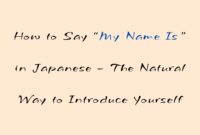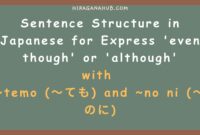Negative Verb Conjugation in Japanese (Nai-kei)
Good evening, it’s time for another Japanese lesson. Today, we will learn
about negative verb conjugation, or nai-kei (the negative form). If you’re new to this topic, don’t worry—I’ll
explain everything step by step. Let’s get started!

Understanding Verb Groups in Japanese
Before jumping into negative conjugation, knowing how Japanese verbs are
grouped is important. If you haven’t learned about verb classification yet, I
recommend checking out the groups of Japanese verbs first.
Once you have that down, we can dive into how to form the negative.
Group 1 Verbs (Godan Doushi)
Group 1 verbs, or godan doushi (ごだんどうし), change based on their
ending. The rule for conjugating to the negative is simple: replace the final
u sound with an a sound (except for
u and tsu, which change to wa and ta respectively).
Then, add ない (nai) at the end.
For example:
-
かう (kau) : to buy →
かわない (kawanai) : not buying -
はなす (hanasu) : to speak →
はなさない (hanasanai) : not speaking -
かつ (katsu) : to win →
かったない (katanai) : not winning -
いそぐ (isogu) : to hurry →
いそがない (isoganai) : not hurrying -
しぬ (shinu) : to die →
しなない (shinanai) : not dying -
かく (kaku) : to write →
かかない (kakanai) : not writing -
のむ (nomu) : to drink →
のまない (nomanai) : not drinking -
かえる (kaeru) : to return →
かえらない (kaeranai) : not returning -
とぶ (tobu) : to fly →
とばない (tobanai) : not flying
Group 2 Verbs (Ichidan Doushi)
Group 2 verbs, or ichidan doushi (いちだんどうし), follow a simpler
pattern. To form the negative, just remove the ru ending and
add ない (nai).
For example:
-
たべる (taberu) : to eat →
たべない (tabenai) : not eating -
みる (miru) : to see →
みない (minai) : not seeing -
しらせる (shiraseru) : to inform →
しらせない (shirasenai) : not informing -
きこえる (kikoeru) : to be heard →
きこえない (kikoenai) : not heard -
みえる (mieru) : to be visible →
みえない (mienai) : not visible -
でる (deru) : to go out →
でない (denai) : not going out -
できる (dekiru) : to be able to →
できない (dekinai) : not able to
Group 3 Verbs (Fukisoku Doushi)
Group 3, or fukisoku doushi (ふきそくどうし), consists of just two
verbs, and they don’t follow the regular conjugation rules. You’ll need to
memorize their negative forms.
-
する (suru) : to do →
しない (shinai) : not doing -
くる (kuru) : to come →
こない (konai) : not coming
Verb Conjugation Summary
Here’s a handy table summarizing all the verb groups and their negative forms:
| Group | Positive Form | Negative Form |
|---|---|---|
| Godan | かう (kau) | かわない (kawanai) |
| はなす (hanasu) | はなさない (hanasanai) | |
| Ichidan | たべる (taberu) | たべない (tabenai) |
| みる (miru) | みない (minai) | |
| Fukisoku | する (suru) | しない (shinai) |
| くる (kuru) | こない (konai) |
Negative conjugation is essential when learning Japanese; it becomes
easier as you practice. Remember these rules for each verb group, and you’ll
get the hang of it quickly! Practice regularly, and soon, you’ll be using
these conjugations naturally.
I hope this lesson was helpful! Keep practising, and feel free to come back
for more lessons. See you next time! 😊


